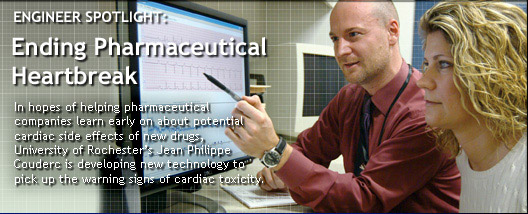Engineer Spotlight: Jean Couderc

For pharmaceutical companies, the antihistamine Seldane is a textbook example of what you don’t want in a new drug. Seldane hit the market as the first nondrowsy allergy medication in 1985. It was a stunning success, quickly becoming one of the top 10 most-prescribed drugs. But the U.S. Food and Drug Administration started to get some alarming reports about the drug. By 1997, when it was pulled from the market, Seldane had been identified as the cause of serious cardiac problems in 83 people. Fifteen of those people died.
Seldane, doctors now know, caused certain patients to develop Long QT Syndrome, a malfunction in the heart’s electrical signaling system named for a split-second lengthening in the time it takes the cardiac muscle to contract and release. The delay can cause the heart to beat out of control or, in some cases, stop altogether.
A genetic defect causes Long QT Syndrome in between 10 and 15 percent of the population. It’s usually to blame when an otherwise healthy child dies, usually while exercising, for no apparent reason. Today more than 30 commonly prescribed drugs carry a very small risk of inducing Long QT Syndrome in people without the genetic defect. More than 70 others are suspected of doing the same.
Considering that it costs about $900 million to get a new drug on the market, pharmaceutical companies would like to learn sooner, rather than later, if their investment is going to turn into a liability. Jean Philippe Couderc, a professor of both biomedical engineering and medicine at New York’s University of Rochester Medical Center and founder of iCardiac Technologies, is developing software that will help pharmaceutical companies do just that.
“The magic words today are ‘translational research,’ making sure that your research is reaching the patient,” Couderc says. He specializes in using digital signal processing to get information from electrical signals in the body. Couderc hopes to use his software to pick up on the small changes in the heart’s electrical system that indicate Long QT Syndrome or other types of cardiac toxicity are developing.
“We have developed a set of electrocardiographic tools to do quantitative analysis of signals coming from the heart,” Couderc explains. Those tools, he continues, can help them determine the warning signs of cardiac toxicity with greater precision and long before the changes are significant enough to pose a threat to the patient. He recently secured a $1 million grant from the National Institutes of Health to validate the software containing a massive data set from FDA’s past clinical trials.
Ultimately, Couderc thinks that drug companies will be able to use the software to pick up on the warning signs of cardiac toxicity much earlier in the approval process. It could even identify people who are at an increased risk of developing drug-induced Long QT Syndrome, so they can avoid potentially dangerous medications altogether.
FOR MORE INFORMATION:
Filed under: Biomedical, Explore Engineering








